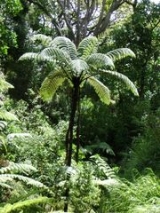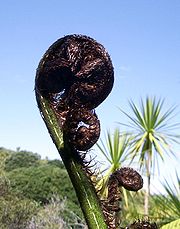
Cyathea medullaris
Encyclopedia
Cyathea medullaris, popularly known as the black tree fern, is a large tree fern up to 20 m tall. It is endemic
to New Zealand
. It is called mamaku, katātā, kōrau, or pītau in the Māori language
.
 C. medullaris is common in lowland forest throughout the North Island
C. medullaris is common in lowland forest throughout the North Island
. In the South Island
its distribution is more localised. It is fairly common in wetter coastal areas, but rare in the drier eastern parts and absent in Canterbury
and Otago
. It also occurs on the Three Kings Islands
in the far north, on Stewart Island/Rakiura
in the far south and in the Chatham Islands
.
 The trunk is black and covered with hexagonal stipe bases. The frond
The trunk is black and covered with hexagonal stipe bases. The frond
s may be up to 5 m long, and arch upwards from the crown. Dead fronds are shed except in very young plants. The primary pinnae are from 40 cm to 1 m long, and the undersides bear scales with marginal spines. The stipe
s are thick, black, very rough to the touch, and covered in black scales with marginal spines. C. medullaris can be readily distinguished from related species by the hexagonal stipe scars on the trunk and by the scales with spines on their margins.
 C. medullaris will grow from fresh spores, but this is slow. Plants are easy to transplant when they are young. It is also possible to plant newly felled trunks which will generally sprout again, provided they are watered with care. They are hardy in various conditions once established.
C. medullaris will grow from fresh spores, but this is slow. Plants are easy to transplant when they are young. It is also possible to plant newly felled trunks which will generally sprout again, provided they are watered with care. They are hardy in various conditions once established.
Endemic (ecology)
Endemism is the ecological state of being unique to a defined geographic location, such as an island, nation or other defined zone, or habitat type; organisms that are indigenous to a place are not endemic to it if they are also found elsewhere. For example, all species of lemur are endemic to the...
to New Zealand
New Zealand
New Zealand is an island country in the south-western Pacific Ocean comprising two main landmasses and numerous smaller islands. The country is situated some east of Australia across the Tasman Sea, and roughly south of the Pacific island nations of New Caledonia, Fiji, and Tonga...
. It is called mamaku, katātā, kōrau, or pītau in the Māori language
Maori language
Māori or te reo Māori , commonly te reo , is the language of the indigenous population of New Zealand, the Māori. It has the status of an official language in New Zealand...
.
Distribution

North Island
The North Island is one of the two main islands of New Zealand, separated from the much less populous South Island by Cook Strait. The island is in area, making it the world's 14th-largest island...
. In the South Island
South Island
The South Island is the larger of the two major islands of New Zealand, the other being the more populous North Island. It is bordered to the north by Cook Strait, to the west by the Tasman Sea, to the south and east by the Pacific Ocean...
its distribution is more localised. It is fairly common in wetter coastal areas, but rare in the drier eastern parts and absent in Canterbury
Canterbury, New Zealand
The New Zealand region of Canterbury is mainly composed of the Canterbury Plains and the surrounding mountains. Its main city, Christchurch, hosts the main office of the Christchurch City Council, the Canterbury Regional Council - called Environment Canterbury - and the University of Canterbury.-...
and Otago
Otago
Otago is a region of New Zealand in the south of the South Island. The region covers an area of approximately making it the country's second largest region. The population of Otago is...
. It also occurs on the Three Kings Islands
Three Kings Islands
The Three Kings Islands or Manawa Islands are a group of 13 islands about northwest of Cape Reinga, the northernmost point of the North Island of New Zealand, where the South Pacific Ocean and Tasman Sea converge. They measure about 4.86 km² in area...
in the far north, on Stewart Island/Rakiura
Stewart Island/Rakiura
Stewart Island/Rakiura is the third-largest island of New Zealand. It lies south of the South Island, across Foveaux Strait. Its permanent population is slightly over 400 people, most of whom live in the settlement of Oban.- History and naming :...
in the far south and in the Chatham Islands
Chatham Islands
The Chatham Islands are an archipelago and New Zealand territory in the Pacific Ocean consisting of about ten islands within a radius, the largest of which are Chatham Island and Pitt Island. Their name in the indigenous language, Moriori, means Misty Sun...
.
Description

Frond
The term frond refers to a large, divided leaf. In both common usage and botanical nomenclature, the leaves of ferns are referred to as fronds and some botanists restrict the term to this group...
s may be up to 5 m long, and arch upwards from the crown. Dead fronds are shed except in very young plants. The primary pinnae are from 40 cm to 1 m long, and the undersides bear scales with marginal spines. The stipe
Stipe (botany)
In botany, a stipe is a stalk that supports some other structure. The precise meaning is different depending on which taxonomic group is being described....
s are thick, black, very rough to the touch, and covered in black scales with marginal spines. C. medullaris can be readily distinguished from related species by the hexagonal stipe scars on the trunk and by the scales with spines on their margins.
Cultivation


